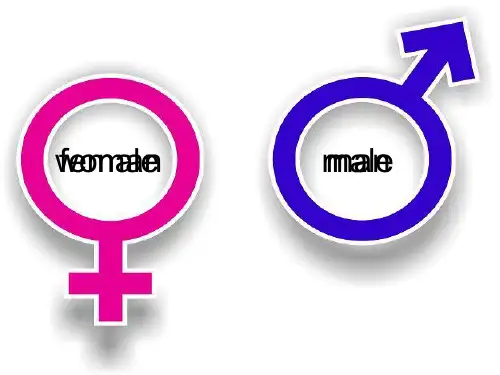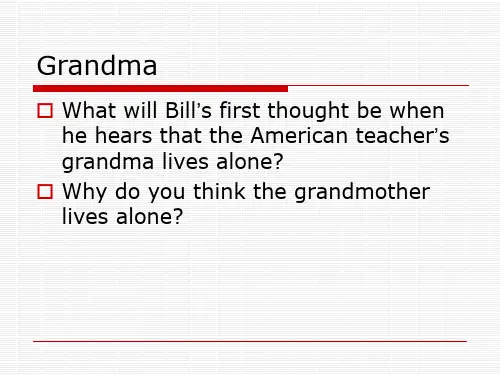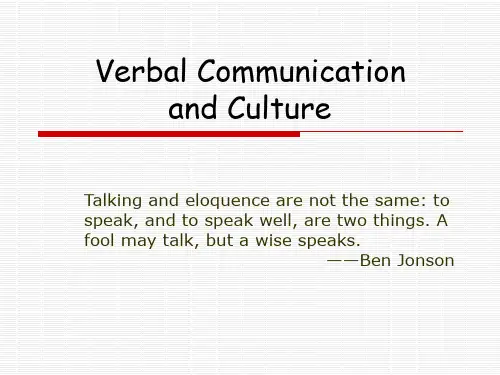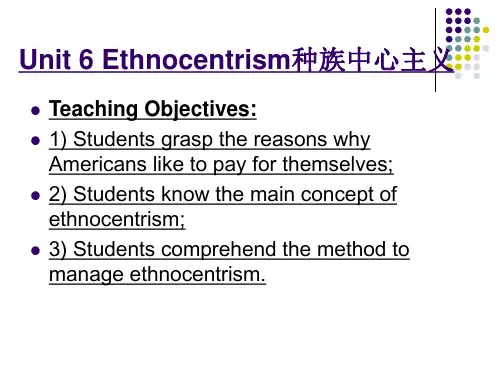跨文化交际上课内容unit6
- 格式:doc
- 大小:928.50 KB
- 文档页数:15









跨⽂化交际上课内容unit6Unit Six Culture and Nonverbal CommunicationI.Warm UpPlease read the story on page 190, then discuss the following questions:1.What is nonverbal communication?2.Is it possible to communicate without nonverbal means? Why or why not?3.What functions does our nonverbal behavior serve in communication?II.Nonverbal Communication?Read the article ―An Overview概况of Nonverbal Communication‖(p191-199). What is nonverbal communication inclusive of 包括according to it?The article illustrates several different kinds of nonverbal behaviors in five parts: paralanguage副语⾔(voice & intonation声调p191-192), kinesics 动作学(gesture p192-193, facial expression –smiles and laugh p1996-197), oculesics 眼神学(eye contact p194-196), haptics触觉学(handshaking & kissing p198-199).Supplement: What is Nonverbal Communication?Nonverbal communication is the process by which nonverbal behaviors are used, either singly or in combination with verbal behaviors, in the exchange and interpretation of messages within a given situation or context. (L. A. Malandro, 1983) Narrowly speaking, nonverbal communication refers to intentional 故意use of to communicate a specific message. Broadly speaking, the term can be defined to refer to elements of ⼀部分theenvironment that communicate by virtue of由于people's use of be defined to refer to elements of the environment that communicate by virtue of people's use of them.(i)※Classifications of nonverbal communication by Knapp in 19721.kinesics or body language: gestures, posture, touch and feeling(handshaking), artifacts, olfaction嗅觉, etc.2.oculesics or eye movements:3.facial expressions:4.proxemics: intimate space (0.5m), personal space (0.5-1.25m), socialspace (1.25-3.5m), and public space (over 3.5m). (Wrightsman etl.1988:284)5.paralanguage: sound, pitch, tempo of speech, turn-taking, silence.(ii) Its features:1.It’s communication in which word s or speech sounds are not used.2.It conveys meaning.3.It involves such non-verbal dimensions规模as facial expressions,touch, time, gestures, smile, eye behaviors, smell, intonation声调, etc.4.It’s a discipline studying non-verbal behavior in communication.5.It’s first of all used to convey messages to and receive messages fromothers.6.It’s a process of communication by means of non-verbal behaviors.7.It may convey messages alone or in combination with verbalbehaviors.8.It occurs in a given context or situation and is interpreted in relation tothat situation or context.(e.g. blush: nervous or shy; biti ng one’s nails) (iii) Its significanceNonverbal behavior is a significant area of communication study for at least three reasons.Nonverbal behavior accounts for占⽐重much of the meaning we get from conversations.Nonverbal behavior spontaneously⾃发地reflects the subconsciousness潜意识. They are relatively free of distortions扭曲失真and deception.We cannot avoid communicating through nonverbal signals. Besides, nonverbal behavior is significant because nonverbal communication can be open to many interpretations.(iv) Its functions (p 218-221):1.Repeating: People use nonverbal communication to repeat, clarify, andemphasize their point of view. For example, nod as saying "yes". (The gestures and words have a similar meaning and reinforce 加强one another.)/doc/3518b87afad6195f302ba650.html plementing: Nonverbal communication cues提⽰can add to or complement a verbal message. For example, scratch抓head, pat轻拍one on the shoulder while saying to him/her. (modify verbal communication by loudness and tone of voice).3.Substituting取代: Nonverbal messages may substitute verbal ones incertain settings. There are situations in which words cannot be used. Ina very noisy street, for example, police officer might use hand gesturesto replace spoken messages. (gestures replace verbal communication) 4.Regulating: Nonverbal behaviors can help control verbal interactions语⾔互动by regulating them, such as turn-taking 话轮转换signals (hand raised) in conversations, nod one’s head in agreement to indicate the speaker to continue talking.5.Contradicting: Certain nonverbal behaviors can contradict spokenwords. E.g. Saying you are relaxed and at ease with quavering voices or shaking hands.6.※Accenting强调: the act of giving special importance orsignificance to something.(v) Gender and Nonverbal CommunicationRead the article ―Gender and Nonverbal Communication‖. Are men and women expected to behave exactly in the same manner even in the same culture?We have to say that there are the so-called 所谓的gender script in every culture. The nonverbal behaviors that result from this socialization are learned rather than innate先天的, and they become part of an individual’s experience as a ―gendered self‖. For instance, to sit like a lady, not to cry to be a man, etc.1.Touch, like physical closeness亲密, may be considered an expressionof affection, support, or sexual attraction. For instance, in some cultures,it may be all right for women friends and relatives to walk arm-in-arm, dance together, and hug one another, but if men do so, they may be frowned upon皱眉不赞同, for they would be considered homosexual 同性恋. On the other hand, touch may beused to express and maintain an asymmetrical⾮对称的relationship as well as a reciprocal 互惠one. For example, the doctor and the patient; the department head and the secretary. In this case, the former are usually male-oriented.2.The height and power differential between the sexes: In a world inwhich height equals power and women are not supposed to be more powerful than men⼥性不应⽐男性强⼤, taller women may attempt to diminish 缩⼩themselves, to slouch 没精打采and round their shoulders so as to retreat or to occupy as little space as possible.3.Men and women are not usually required to have the same facialexpressions. Smile may mean different things to men and women. For females smile functions as an expression of pleasure, pleasantness, or a desire for approval, while males may resist any nonverbal display of expression to others in order to appear more masculine阳刚, because being facially expressive is often seen as a marker of ―femininity‖.⼥性⽓质4.Through clothing and make-up, the body is more or less marked,constituted as an appropriate, or, as the case may be, in appropriate body for its cultural requirements. Males and females have to dress themselves appropriately according to their cultural definitions ofmasculinity and femininity.5.It is important to remember that the notion of ―appropriate‖ nonverbalbehavior is largely culturally determined. White, middle-class women in the US are expected to be highly expressive emotionally. However, African-American women are not expected in exactly the same manner.Dominant members of a hierarchy等级制度are less likely to smile or disclose公开their feelings nonverbally.III.Paralanguage (p191-192, p223-224) 副语⾔,伴随语⾔We communicate with more than the words we speak. Effective speakers use vocal qualities to suggest different meanings from exactly the same words, like the manner of speech, intonation.Paralanguage / Metacommunication are the accompanying features of the voice.a. voice set: the context in which the speaker is speaking: the situation,gender, mood, age, person’s culture;b. voice qualities: volume, pitch⾳⾼, tempo, rhythm, articulation发⾳,resonance共鸣, nasality⿐⾳, accent重读;c. vocalization发声: characterizers, qualifiers, segregates分离.IV.Kinesics体姿语Kinesics, that is commonly called as body language, is the term used for communicating through various types of body movements including gestures, posture, touching, and other mannerisms that may accompany or replace oral messages. (i) Gestures: (p192-193)Gestures are an important component of non-verbal communication. This is mainly a matter of how we use our hands to convey a message. The language of the hands differs from country to country and a gesture which means one thing in one country may well mean something quite different to those living in another.Gestures can be emblems象征or’s face turns red with embarrassment). Gestures are used to add emphasis or clarity to an oral message.①It’s me or I’m the one—touch or poin t to one’s nose by raised thumb.②Come here—extending a closed hand, palm up, with only theforefinger moving back and forth.③Shame on you—extending both hands, palms down, with forefingersstretching out and one forefinger makes several brushing movements over the back of the other forefinger.④Hitchhiking搭便车旅⾏—moving several time a closed hand with anoutstretched thumb opinion to the intended direction. (American method)--walking on the same side of the road and in the same directionas the car traffic, and extend the thumb of your roadside armtoward the front. (European method)在车辆⾏驶的那边公路上,朝车开的⽅向⾏⾛,同时将靠边那只⼿臂的拇指伸向前⽅。


Unit Six Culture and Nonverbal CommunicationI.Warm UpPlease read the story on page 190, then discuss the following questions:1.What is nonverbal communication?2.Is it possible to communicate without nonverbal means? Why or why not?3.What functions does our nonverbal behavior serve in communication?II.Nonverbal Communication?Read the article ―An Overview概况of Nonverbal Communication‖(p191-199). What is nonverbal communication inclusive of包括according to it?The article illustrates several different kinds of nonverbal behaviors in five parts: paralanguage副语言(voice & intonation声调p191-192), kinesics 动作学(gesture p192-193, facial expression –smiles and laugh p1996-197), oculesics 眼神学(eye contact p194-196), haptics触觉学(handshaking & kissing p198-199).Supplement: What is Nonverbal Communication?Nonverbal communication is the process by which nonverbal behaviors are used, either singly or in combination with verbal behaviors, in the exchange and interpretation of messages within a given situation or context. (L. A. Malandro, 1983)Narrowly speaking, nonverbal communication refers to intentional 故意use of to communicate a specific message. Broadly speaking, the term can be defined to refer to elements of 一部分theenvironment that communicate by virtue of由于people's use of be defined to refer to elements of the environment that communicate by virtue of people's use of them.(i)※Classifications of nonverbal communication by Knapp in 19721.kinesics or body language: gestures, posture, touch and feeling(handshaking), artifacts, olfaction嗅觉, etc.2.oculesics or eye movements:3.facial expressions:4.proxemics: intimate space (0.5m), personal space (0.5-1.25m), socialspace (1.25-3.5m), and public space (over 3.5m). (Wrightsman etl.1988:284)5.paralanguage: sound, pitch, tempo of speech, turn-taking, silence.(ii) Its features:1.It’s communication in which word s or speech sounds are not used.2.It conveys meaning.3.It involves such non-verbal dimensions规模as facial expressions,touch, time, gestures, smile, eye behaviors, smell, intonation声调, etc.4.It’s a discipline studying non-verbal behavior in communication.5.It’s first of all used to convey messages to and receive messages fromothers.6.It’s a process of communication by means of non-verbal behaviors.7.It may convey messages alone or in combination with verbalbehaviors.8.It occurs in a given context or situation and is interpreted in relation tothat situation or context.(e.g. blush: nervous or shy; biti ng one’s nails) (iii) Its significanceNonverbal behavior is a significant area of communication study for at least three reasons.♦Nonverbal behavior accounts for占比重much of the meaning we get from conversations.♦Nonverbal behavior spontaneously自发地reflects the subconsciousness潜意识. They are relatively free of distortions扭曲失真and deception.♦We cannot avoid communicating through nonverbal signals. Besides, nonverbal behavior is significant because nonverbal communication can be open to many interpretations.(iv) Its functions (p 218-221):1.Repeating: People use nonverbal communication to repeat, clarify, andemphasize their point of view. For example, nod as saying "yes". (The gestures and words have a similar meaning and reinforce 加强one another.)plementing: Nonverbal communication cues提示can add to orcomplement a verbal message. For example, scratch抓head, pat轻拍one on the shoulder while saying to him/her. (modify verbal communication by loudness and tone of voice).3.Substituting取代: Nonverbal messages may substitute verbal ones incertain settings. There are situations in which words cannot be used. Ina very noisy street, for example, police officer might use hand gesturesto replace spoken messages. (gestures replace verbal communication) 4.Regulating: Nonverbal behaviors can help control verbal interactions语言互动by regulating them, such as turn-taking 话轮转换signals (hand raised) in conversations, nod one’s head in agreement to indicate the speaker to continue talking.5.Contradicting: Certain nonverbal behaviors can contradict spokenwords. E.g. Saying you are relaxed and at ease with quavering voices or shaking hands.6.※Accenting强调: the act of giving special importance orsignificance to something.(v) Gender and Nonverbal CommunicationRead the article ―Gender and Nonverbal Communication‖. Are men and women expected to behave exactly in the same manner even in the same culture?We have to say that there are the so-called 所谓的gender script in every culture. The nonverbal behaviors that result from this socialization are learned rather than innate先天的, and they become part of an individual’s experience as a ―gendered self‖. For instance, to sit like a lady, not to cry to be a man, etc.1.Touch, like physical closeness亲密, may be considered an expressionof affection, support, or sexual attraction. For instance, in some cultures,it may be all right for women friends and relatives to walk arm-in-arm, dance together, and hug one another, but if men do so, they may be frowned upon皱眉不赞同, for they would be considered homosexual 同性恋. On the other hand, touch may be used to express and maintain an asymmetrical非对称的relationship as well as a reciprocal 互惠one. For example, the doctor and the patient; the department head and the secretary. In this case, the former are usually male-oriented.2.The height and power differential between the sexes: In a world inwhich height equals power and women are not supposed to be more powerful than men女性不应比男性强大, taller women may attempt to diminish 缩小themselves, to slouch 没精打采and round their shoulders so as to retreat or to occupy as little space as possible.3.Men and women are not usually required to have the same facialexpressions. Smile may mean different things to men and women. For females smile functions as an expression of pleasure, pleasantness, or a desire for approval, while males may resist any nonverbal display of expression to others in order to appear more masculine阳刚, because being facially expressive is often seen as a marker of ―femininity‖.女性气质4.Through clothing and make-up, the body is more or less marked,constituted as an appropriate, or, as the case may be, in appropriate body for its cultural requirements. Males and females have to dress themselves appropriately according to their cultural definitions ofmasculinity and femininity.5.It is important to remember that the notion of ―appropriate‖ nonverbalbehavior is largely culturally determined. White, middle-class women in the US are expected to be highly expressive emotionally. However, African-American women are not expected in exactly the same manner.Dominant members of a hierarchy等级制度are less likely to smile or disclose公开their feelings nonverbally.III.Paralanguage (p191-192, p223-224) 副语言,伴随语言We communicate with more than the words we speak. Effective speakers use vocal qualities to suggest different meanings from exactly the same words, like the manner of speech, intonation.Paralanguage / Metacommunication are the accompanying features of the voice.a. voice set: the context in which the speaker is speaking: the situation,gender, mood, age, person’s culture;b. voice qualities: volume, pitch音高, tempo, rhythm, articulation发音,resonance共鸣, nasality鼻音, accent重读;c. vocalization发声: characterizers, qualifiers, segregates分离.IV.Kinesics体姿语Kinesics, that is commonly called as body language, is the term used for communicating through various types of body movements including gestures, posture, touching, and other mannerisms that may accompany or replace oral messages.(i) Gestures: (p192-193)Gestures are an important component of non-verbal communication. This is mainly a matter of how we use our hands to convey a message. The language of the hands differs from country to country and a gesture which means one thing in one country may well mean something quite different to those living in another.Gestures can be emblems象征or’s face turns red with embarrassment). Gestures are used to add emphasis or clarity to an oral message.①It’s me or I’m the one—touch or poin t to one’s nose by raised thumb.②Come here—extending a closed hand, palm up, with only theforefinger moving back and forth.③Shame on you—extending both hands, palms down, with forefingersstretching out and one forefinger makes several brushing movements over the back of the other forefinger.④Hitchhiking搭便车旅行—moving several time a closed hand with anoutstretched thumb opinion to the intended direction. (American method)--walking on the same side of the road and in the same directionas the car traffic, and extend the thumb of your roadside armtoward the front. (European method)在车辆行驶的那边公路上,朝车开的方向行走,同时将靠边那只手臂的拇指伸向前方。